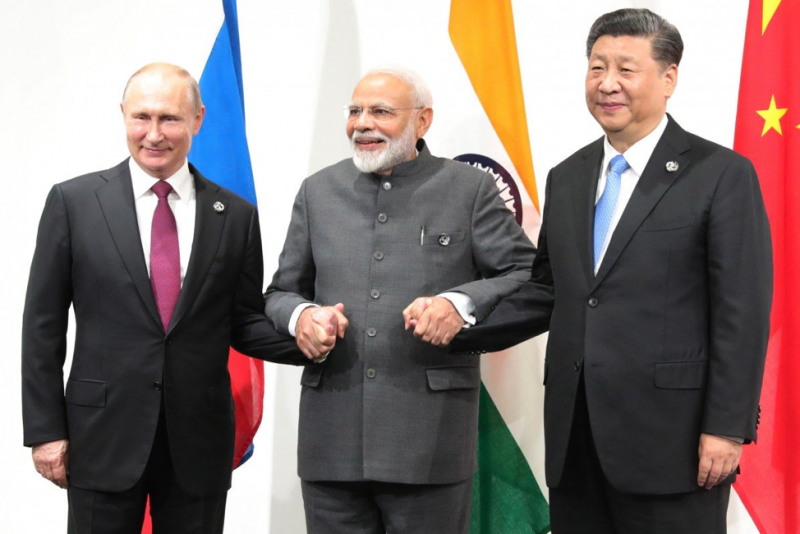
There was a curious hype among Indian analysts over the Russia-India-China videoconference of foreign ministers that took place yesterday. Even the compulsive detractors of processes such as RCI, BRICS and SCO that excluded the US were taking interest.
The RIC process as such is not the focal point here but the strange coincidence of the immediate backdrop of India-China border tensions. The RIC process ought have evolved over time as a dynamic vector of India’s foreign policy. But that never happened.
Several reasons can be attributed to it, but principally, there are four factors:
- India is not a great team player and feels self-confident while pursuing its interests via bilateral channels;
- India is wary of giving any impression that it is ‘ganging up’ with two great ‘revisionist’ powers in the US’ crosshairs on global chessboard — Russia and China;
- India feels constrained in the Russia-India-China triangle due to its troubled relationship with China; and, most important,
- India is intensely conscious that Washington regards the RIC as a hostile entity, which could weaken or undermine the American strategies in Asia and globally; a fully-loaded RIC is not an option for India given its manifest alignment with the anti-China ‘Quad’ platform.
Yesterday’s videoconference was a virtual conference and there wasn’t going to be any ‘pull-aside’ between External Affairs Minister S. Jaishankar and his Chinese counterpart Wang Yi. The event was even more formal than usual.
That is to say, there was no reason to expect the event to open the door to a pathway leading to the rose garden in India-China relations.
On the contrary, what was at stake is that a reset in India-China relationship will be a long, tortuous bilateral process. The conditions for a meaningful strategic communication do not even exist in India at the moment. The hawks are still up in the skies and refuse to descend to mother earth.
Nonsensical talk dominates the Indian narrative and many — including a former defence minister — have articulated absurd notions that Indian military capability in the Himalayas is more than a match for the PLA.
There is even triumphalism that Indian Army killed a commanding officer of the PLA in the Galwan Valley. Meanwhile, the ultra-nationalists are burning Xi Jinping’s pictures. Many among the ruling elite seek a ‘boycott’ of trade and commerce with China.
And then, there are the wild fantasies that due to the coronavirus and economic dislocation, China has been significantly weakened and the Chinese Communist Party is barely shoring up its support base.
Like the tramps in Samuel Beckett’s play Waiting for Godot, Indians are waiting for the US to ‘decouple’ from China; Japan to create a ‘second front’ against China over Senkaku Islands; and Australia to bleed China white with sniper rifles.
Clearly, this surreal setting hangs like an Albatross around Jaishankar’s neck. Nonetheless, being the hardcore realist he is, Jaishankar can be trusted to inch forward his communication with Wang even within the severe constraints of a virtual meeting.
The real significance of the RIC meeting is that it is taking place. Following the one-on-one with PM Modi on June 16, Jaishankar followed up with a request to speak to Wang (to which the latter promptly agreed).
And, it was after the conversation with Wang on June 17, where the two top diplomats reached some common ground as to the way out of the foxhole in Galwan Valley, that Jaishankar signalled his convenience to attend the RIC meet on June 23.
It was a positive signal. Suffice to say, with PM’s approval, Jaishankar opened a political track with Beijing.
Any interaction henceforth between Jaishankar and the Chinese leadership, therefore, constitutes a meaningful step forward. Today’s RIC meeting will be a sufficient enough breakthrough if a bilateral meeting ensues sometime in a near future.
Indian analysts have gone haywire to estimate that Russia is wading into the Sino-Indian relationship. This is a misconception. President Vladimir Putin is not a fire fighter, although he has a rare genius as a world statesman to talk sense and inject rationality into conflict situations.
Second, the alchemy of Russia-China entente must be understood: both sides have ample space to independently pursue their core interests — and, Moscow would be aware that territorial sovereignty is a core issue for China. Third, Russia and China do not necessarily agree on all topics under the sun.
Having said that, Moscow and Beijing place great store in the RIC format as an important dimension to their common strategy to democratise the international system and to consolidate the world opinion on the imperatives of strict adherence to international law and the UN Charter in inter-state conduct.
Simply put, from the Russian and Chinese perspective, the RIC supplements BRICS and the SCO while there is also the plus factor that RIC is their sole exclusive forum with India, whom both powers see as an increasingly significant player in the multilateral arena and a rising star in Asia whose Eurasian integration is in their interests.
Of course, Russia and China are practitioners of the zen of creating synergy out of multilateral formats for enriching and strengthening their bilateral relationship, to harmonise divergences, if any, and to keep deepening their strategic convergence on regional and global issues.
India tends to take an ‘all-or-nothing’ attitude, which is unfortunate. Perhaps, one good thing to come out India’s participation in the RIC meeting lies in the signalling of its growing awareness of the hidden charms of this unique format in a world in historic transition.
The way forward lies, arguably, in the three RIC countries undertaking some common projects in which all three become stakeholders in their shared future.
Originally published by OrientalReview.org
The 21st Century
The views expressed in this article are solely those of the author and do not necessarily reflect the opinions of 21cir.
